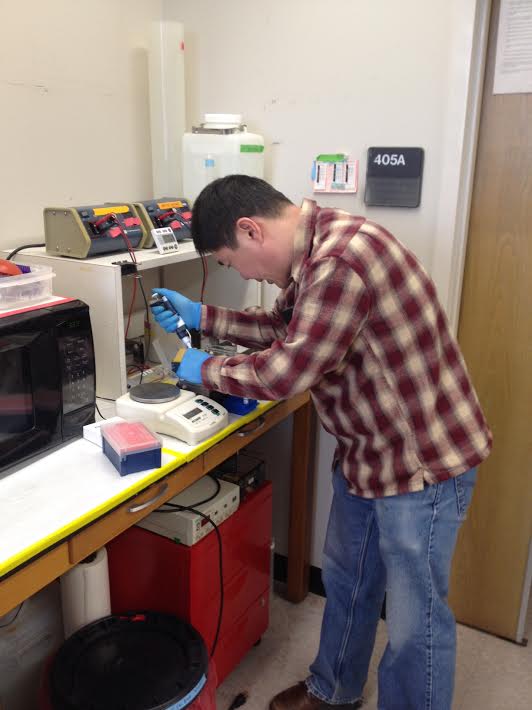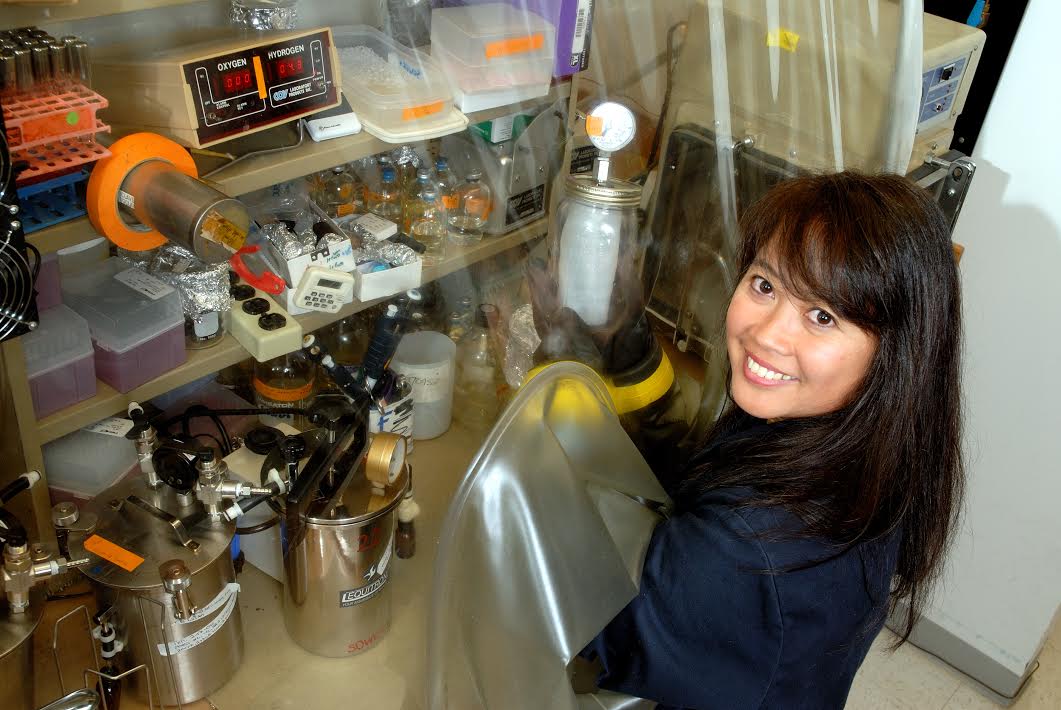by Sarah Hansen
Last spring, the Institute of Marine and Environmental Technology (IMET) initiated the IMET–Partner Institutions Seed Grant Program. The program stipulates that proposals include team members from IMET and at least one of its partner institutions, which include UMBC, University of Maryland–Baltimore (UMB), and the University of Maryland Center for Environmental Science (UMCES). “Our seed grant program is an excellent example of the way that IMET can serve as a catalyst for collaboration among our partner institutions,” said IMET Director Russell Hill. The selection committee chose four projects in the first cycle to fund $100,000 each.
Algae project works toward commercially competitive biofuels
Steve Miller, Associate Professor of Biological Sciences at UMBC, and Yantao Li, Assistant Professor affiliated with IMET and UMCES, submitted one of the winning proposals. Li’s and Miller’s work focuses on producing algal biofuels. Biofuel production “can kill three birds with one stone,” said Miller. First, algal biofuel production is carbon neutral, because algae produce fuel by drawing carbon dioxide out of the air during photosynthesis. Second, if successfully optimized, algal biofuels could provide an alternative fuel source as global fossil fuel deposits dwindle. Third, algae can be used to treat waste water, because they thrive in environments with an excess of water pollutants like nitrogen and phosphorus.
Miller’s lab works on a commonly-studied alga, Chlamydomonas reinhardtii. There are lots of genetic tools for manipulating it in the lab, but it’s not that great at producing oils (fuel) and it doesn’t do well in the harsh conditions inside scaled-up bioreactors. Li has been working with a different species, Nannochloropsis oceanica, for which there are fewer tools. However, it’s hardier and produces more oil. “We’re trying to complement each other’s strengths,” said Miller. “Our goal has been to try to learn something about algal biology, with the hope of improving algal growth rates, and then translate that information to algae that make more oil and are better commercial producers.”
Transferring technical methods from Chlamy to Nanno (as they’re affectionately known) is a real challenge, though. Even though they are both algae, “Nanno is as different from Chlamy as we are from Chlamy,” said Miller. Plus, the same sturdiness that makes Nanno great for industrial production makes it much less amenable to manipulation by researchers, explained Rudy Park, a PhD student in Miller’s lab.

Rudy Park, who is funded by an IMET seed grant, works on the algal biofuels project in Professor Steve Miller's lab at UMBC. (Sarah Hansen)
The seed grant has been critical to progress on this project. Although Li and Miller met several years ago, “The seed grant was the catalyst for getting a collaboration going between us,” Miller said. He’s been able to fund Park and and buy supplies for two master’s students to work on the project. Plus, “Collaboration always makes science more fun,” he said, “It’s more fun to bounce ideas off other people who have the same stake in the process that I do.”
One goal of the grant program is to stimulate submission of grants for external funding. Miller, Li, and Ian Thorpe, UMBC Assistant Professor of Chemistry and Biochemistry, are submitting a grant to the National Science Foundation. Their proposed project hopes to elucidate the oil-producing pathway in Nanno.
Understanding a methane-producing microbe's adaptable metabolism
Kevin Sowers, Associate Director of IMET and UMBC Professor, and C.S. Raman, Associate Professor of Pharmaceutical Sciences at UMB, submitted another of the winning proposals. Sowers and Raman are investigating the ability of a microbe called Methanosarcina barkeri to use oxygen. It belongs to a large and diverse group of single-celled organisms called Archaea. It’s also a methanogen—an organism that releases methane as a byproduct of its metabolism. According to Sowers, “It’s responsible for 70 percent of the methane that’s out there.”
Instead of using oxygen to produce cellular energy (as animals do), M. barkeri uses a variety of molecules including hydrogen, acetate, and methylamines. While some Archaeans are dependent primarily on hydrogen, M. barkeri is “a jack of all trades,” said Sowers. “When there isn’t much hydrogen, these are the ones that take off.”
Previously, scientists believed that oxygen was toxic to methanogens. However, genetic analyses revealed that M. barkeri may be able to use oxygen after all. Turns out it expresses a type of gene used for oxygen-driven energy production called a cytochrome. Raman and Sowers believe the Archaean essentially “stole” the gene from a bacterial cell. Through their project, they hope to solidify evidence that M. barkeri can transition from anaerobic to aerobic metabolism at certain concentrations of oxygen, and elucidate the chemical pathways that regulate that transition.
This investigation has implications for many research fields. M. barkeri and other anaerobic methanogens are critical for nutrient cycling on Earth, because they can break down organic material in anaerobic soils and sediments, returning carbon to the environment. Also, the lateral transfer of genes from a bacterium to an Archaean has implications for evolutionary biology.

Ethel Apolinario, research assistant and lab manager in Professor Kevin Sowers' lab, works with methanogens in an anaerobic glove box. (Kevin Sowers)
Since they received the grant money in Summer 2014, the two have been hard at work. “We’re pushing the oxygen limits,” Sowers said. M. barkeri can hunker down in a dormant state to survive conditions with higher oxygen levels, but they want to find the highest level of oxygen at which it can still grow. So far, they’re up to two percent oxygen and the microbes are still thriving. They’re also analyzing what genes are expressed when oxygen is present, and wondering if the “stolen” cytochrome gene will be active.
The collaboration between Sowers and Raman “is a perfect complementation,” said Sowers. “He’s not an anaerobic microbiologist, and I don’t work with cytochromes.” The two scientists have known each other for many years. “We’d always talked about doing this,” Sowers said, “but we never could quite get something together.” The seed grant “was the catalyst that got it rolling.” Leveraging the preliminary data they’ve collected with funds from the seed grant, Sowers and Raman have submitted grants to NASA and DOE, and they’re looking for other opportunities.
It’s clear that the nascent seed grant program is already making an impact. The winners, who also include Michael Gonsior (UMCES) and Feng Chen (IMET-UMCES), have to report their progress a month after their year of funding runs out, but Hill points out, “We’ll know the true value of the program only a year or two after the end-date, when we see whether these seed grants have led to competitive, large federal awards.”
Last spring, the Institute of Marine and Environmental Technology (IMET) initiated the IMET–Partner Institutions Seed Grant Program. The program stipulates that proposals include team members from IMET and at least one of its partner institutions, which include UMBC, University of Maryland–Baltimore (UMB), and the University of Maryland Center for Environmental Science (UMCES). “Our seed grant program is an excellent example of the way that IMET can serve as a catalyst for collaboration among our partner institutions,” said IMET Director Russell Hill. The selection committee chose four projects in the first cycle to fund $100,000 each.
Algae project works toward commercially competitive biofuels
Steve Miller, Associate Professor of Biological Sciences at UMBC, and Yantao Li, Assistant Professor affiliated with IMET and UMCES, submitted one of the winning proposals. Li’s and Miller’s work focuses on producing algal biofuels. Biofuel production “can kill three birds with one stone,” said Miller. First, algal biofuel production is carbon neutral, because algae produce fuel by drawing carbon dioxide out of the air during photosynthesis. Second, if successfully optimized, algal biofuels could provide an alternative fuel source as global fossil fuel deposits dwindle. Third, algae can be used to treat waste water, because they thrive in environments with an excess of water pollutants like nitrogen and phosphorus.
Miller’s lab works on a commonly-studied alga, Chlamydomonas reinhardtii. There are lots of genetic tools for manipulating it in the lab, but it’s not that great at producing oils (fuel) and it doesn’t do well in the harsh conditions inside scaled-up bioreactors. Li has been working with a different species, Nannochloropsis oceanica, for which there are fewer tools. However, it’s hardier and produces more oil. “We’re trying to complement each other’s strengths,” said Miller. “Our goal has been to try to learn something about algal biology, with the hope of improving algal growth rates, and then translate that information to algae that make more oil and are better commercial producers.”
Transferring technical methods from Chlamy to Nanno (as they’re affectionately known) is a real challenge, though. Even though they are both algae, “Nanno is as different from Chlamy as we are from Chlamy,” said Miller. Plus, the same sturdiness that makes Nanno great for industrial production makes it much less amenable to manipulation by researchers, explained Rudy Park, a PhD student in Miller’s lab.
Rudy Park, who is funded by an IMET seed grant, works on the algal biofuels project in Professor Steve Miller's lab at UMBC. (Sarah Hansen)
The seed grant has been critical to progress on this project. Although Li and Miller met several years ago, “The seed grant was the catalyst for getting a collaboration going between us,” Miller said. He’s been able to fund Park and and buy supplies for two master’s students to work on the project. Plus, “Collaboration always makes science more fun,” he said, “It’s more fun to bounce ideas off other people who have the same stake in the process that I do.”
One goal of the grant program is to stimulate submission of grants for external funding. Miller, Li, and Ian Thorpe, UMBC Assistant Professor of Chemistry and Biochemistry, are submitting a grant to the National Science Foundation. Their proposed project hopes to elucidate the oil-producing pathway in Nanno.
Understanding a methane-producing microbe's adaptable metabolism
Kevin Sowers, Associate Director of IMET and UMBC Professor, and C.S. Raman, Associate Professor of Pharmaceutical Sciences at UMB, submitted another of the winning proposals. Sowers and Raman are investigating the ability of a microbe called Methanosarcina barkeri to use oxygen. It belongs to a large and diverse group of single-celled organisms called Archaea. It’s also a methanogen—an organism that releases methane as a byproduct of its metabolism. According to Sowers, “It’s responsible for 70 percent of the methane that’s out there.”
Instead of using oxygen to produce cellular energy (as animals do), M. barkeri uses a variety of molecules including hydrogen, acetate, and methylamines. While some Archaeans are dependent primarily on hydrogen, M. barkeri is “a jack of all trades,” said Sowers. “When there isn’t much hydrogen, these are the ones that take off.”
Previously, scientists believed that oxygen was toxic to methanogens. However, genetic analyses revealed that M. barkeri may be able to use oxygen after all. Turns out it expresses a type of gene used for oxygen-driven energy production called a cytochrome. Raman and Sowers believe the Archaean essentially “stole” the gene from a bacterial cell. Through their project, they hope to solidify evidence that M. barkeri can transition from anaerobic to aerobic metabolism at certain concentrations of oxygen, and elucidate the chemical pathways that regulate that transition.
This investigation has implications for many research fields. M. barkeri and other anaerobic methanogens are critical for nutrient cycling on Earth, because they can break down organic material in anaerobic soils and sediments, returning carbon to the environment. Also, the lateral transfer of genes from a bacterium to an Archaean has implications for evolutionary biology.
Ethel Apolinario, research assistant and lab manager in Professor Kevin Sowers' lab, works with methanogens in an anaerobic glove box. (Kevin Sowers)
Since they received the grant money in Summer 2014, the two have been hard at work. “We’re pushing the oxygen limits,” Sowers said. M. barkeri can hunker down in a dormant state to survive conditions with higher oxygen levels, but they want to find the highest level of oxygen at which it can still grow. So far, they’re up to two percent oxygen and the microbes are still thriving. They’re also analyzing what genes are expressed when oxygen is present, and wondering if the “stolen” cytochrome gene will be active.
The collaboration between Sowers and Raman “is a perfect complementation,” said Sowers. “He’s not an anaerobic microbiologist, and I don’t work with cytochromes.” The two scientists have known each other for many years. “We’d always talked about doing this,” Sowers said, “but we never could quite get something together.” The seed grant “was the catalyst that got it rolling.” Leveraging the preliminary data they’ve collected with funds from the seed grant, Sowers and Raman have submitted grants to NASA and DOE, and they’re looking for other opportunities.
It’s clear that the nascent seed grant program is already making an impact. The winners, who also include Michael Gonsior (UMCES) and Feng Chen (IMET-UMCES), have to report their progress a month after their year of funding runs out, but Hill points out, “We’ll know the true value of the program only a year or two after the end-date, when we see whether these seed grants have led to competitive, large federal awards.”
Tags:
Posted: March 13, 2015, 4:32 PM
